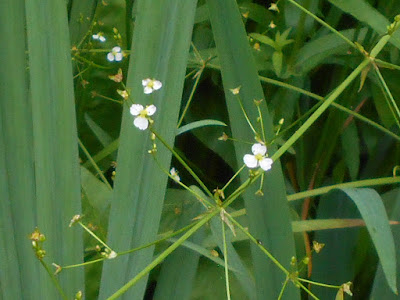I was checking over some St John's Wort when, among a clump of weedy growth nearby a splash of blue caught my eye. Closer examination showed that the plant in question was Nettle-leaved Bellflower, Campanula trachelium, a tall and vigorous relation of the Harebell, Campanula rotundifolia, which grows about half a mile away on Solden Hill.
 |
| The Nettle-leaved Bellflower is new to Byfield Pocket Park. 31 July, 2019 |
Several spikes of the bellflower were present, attracting numerous insects, particularly small beetles. It could be a throw-out from a garden but I have not noticed it being grown in Byfield and it is a native plant. The leaves are distinctive and are more important to identification than the flowers.
 |
The form of the leaves is helpful in distinguishing it from other
bellflowers.
|
Interestingly, the latest flora for Northamptonshire states: 'There are no records of garden escapes in this county'. (Reference 1). The specific name trachelium is also interesting. Basically it means 'neck' and indeed comes from the Greek trachylos, the neck (think trachea). The plant was once reputed to be good for throat ailments and one of its old names is Throatwort.
An oak tree stood nearby and I made a cursory check (I couldn't be too long as I had an appointment at the hairdressers) for galls. Rather pleasingly I found a few specimens of Ramshorn Gall, caused by the wasp Andricus aries. This insect and its gall were unknown in Britain before 1997, when it was found in Berkshire. Since then its spread has been rapid and is well established as far north as Perthshire.
 |
The Ramshorn Gall was in interesting find in the pocket park today
31 July, 2019
|
In many specimens the 'horns' can become long and rather curved - very ramshorn-shaped. The specimens I photographed were hardly spectacular but interesting nevertheless.
This is a good times of the year to be finding flea beetles. Of course they are completely unrelated to true fleas but have powerful muscles in their 'thighs', enabling them to jump considerable distances. Often very tiny, (and tricky to identify, Ref. 2) they are a challenge to my little camera and this is the best I could manage.
 |
This metallic-bronze beetle on aspen proved to be Crepidodera aurea.
It is one of the many species of flea beetle in the U.K. 31 July 2019
|
The specimen shown is Crepidodera aurea, and was on Aspen, Populus tremula. This small (3.5 mm) beetle is widespread in England but was a 'first' for the pocket park, even so it only raises the total to a meagre 117 species. Lots to be done!
References
1. Gent, G. and Wilson, R. (2012) The Flora of Northamptonshire and the Soke of Peterborough.
2. Hubble, D. (2012) Keys to the adults of seed and leaf beetles of Britain and Ireland.
Field Studies Council Publications.
References
1. Gent, G. and Wilson, R. (2012) The Flora of Northamptonshire and the Soke of Peterborough.
2. Hubble, D. (2012) Keys to the adults of seed and leaf beetles of Britain and Ireland.
Field Studies Council Publications.













































